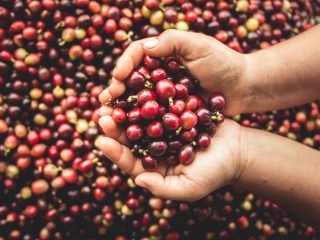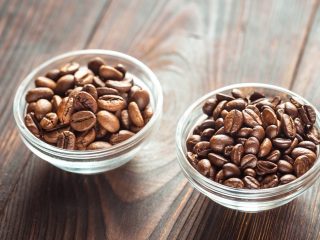Nuts support memory, carrots are good for your eyesight, and coffee… gets you on your feet! And it’s not just an empty cliche. Coffee is credited with such extraordinary power for a reason. We reach for it when we struggle with fatigue, drowsiness, when we’re tired or want to improve concentration. It owes its effectiveness to the caffeine it contains. So, what should we know about this substance when reaching for another cup of coffee? How much caffeine can we drink per day?
What is C8H10N4O2?
C8H10N4O2, called: caffeine, theine, mateine, guaranine – all those names stand for the same compound, and terminology depends on its source of origin:
- caffeine from coffee beans
- theine from leaves of the tea bush
- mateine from leaves of the Paraguayan holly (yerba mate)
- guaranine from guarana seeds
Caffeine is a purine alkaloid – a compound with a psychoactive effect – associated primarily with coffee, which is the main source of caffeine among Europeans. Another, equally common sources of caffeine in our diet are tea, cocoa and the increasingly popular yerba mate. Caffeine is also found in cola-type and energy drinks. The fact is that the latter have little to do with healthy eating, so it is good to limit their amount in our diet and ensure a qualitatively good source of C8H10N4O2. Of course, remember that also in the case of coffee, there is a maximum allowable dose of caffeine.

Caffeine metabolism
Probably many of us know a person who feels over-agitated after drinking just one coffee and rather avoids frequent consumption. On the opposite end are people who have drink a few coffees a day as a sort of their ritual, they do not experience any side effects and enjoy another cup of coffee with pleasure. What are the reasons for such differences? And does this mean that the maximum daily dose of caffeine will be higher for some and lower for others?
On this matter, we must dive into the realm of genetics. The metabolism of caffeine takes place mainly in the liver with the participation of cytochrome P450 (more precisely isoenzyme 1A2). In case of some people, this enzyme works quickly, caffeine is efficiently metabolized and removed from the blood, and so they can usually drink coffee without noticing any side effects.
On the other hand, for people with less active enzyme, the metabolism of caffeine is slower, and thus caffeine metabolites remain in the blood for longer. Such people may feel irritation, headache, and be over-agitated after just one cup of coffee. This difference is due to the existence of different variants of the CYP1A2 gene, which makes some people fast coffee metabolizers, and others – slow metabolizers. Genetics is just one factor, and we can list a few more, including age, medications taken, physiological state, smoking, as well as the fact of developing a habit, i.e. tolerance to caffeine.
How much caffeine can we take per day?
Despite the pleasant taste and aroma of coffee or tea and the amount of health-promoting compounds they provide us with, it is worth paying attention to how much caffeine we serve daily to our body.
It has been established that a safe daily dose of caffeine for healthy adults is 400 mg, which is roughly equivalent to an average of 4 cups of coffee. Pregnant women are advised to limit the daily dose of caffeine to 200 mg, due to the fact that caffeine and its metabolites pass through the placenta to the fetus, so excessive consumption of caffeine may adversely affect the baby’s development. Breastfeeding women are also advised to limit caffeine consumption due to the possible transfer of caffeine into milk. The lethal dose of caffeine is reported to be 150–200 mg/kg of body weight.
How do we estimate the daily dose of caffeine in our diet? How much coffee can I drink in a day?
We already know that caffeine is not only in coffee. We also know that it is recommended not to exceed the allowable dose of 400 mg of caffeine per day. So, what amounts of caffeine can we expect in the drinks we consume?

First of all, it is worth realizing how many factors really affect the amount of caffeine in a cup of coffee which will ultimately land on your table. Starting from the growing conditions, through the roasting process, to the size of the grind or the brewing method. There are also differences in the type of coffee – for example, Robusta contains up to twice as much caffeine as Arabica. Hence, you are often given the caffeine range for beverages.
- Espresso (30 ml) – approx. 60 mg
- Instant coffee (125 ml) – approx. 65 mg
- Black coffee (125 ml) – approx. 85 mg
- Tea (150 ml) – approx. 32 mg
- Energy drink (330 ml) – approx. 80 mg
When analyzing the above data, it is worth considering what caffeine values you can expect in your diet. It may turn out that by consuming several different caffeinated drinks a day, you may notoriously exceed the safe daily dose.
So, how many coffees a day can you drink?
No two cups are the same. Depending on our preferences, we can enjoy espresso, black coffee, white coffee, americano or latte, which differ in the size of the portion. If we usually drink a double espresso, already 3 such servings a day will be within the upper maximum. In the case of cappuccinos and lattes, the addition of milk doesn’t make the coffee weaker. The caffeine content is determined by the amount of espresso added.

The benefits of caffeine
One of the greatest benefits we’ve identified is stimulation – hardly anyone can imagine a morning without a few sips of coffee. However, there are even more health benefits to it. By stimulating the nervous system, caffeine reduces the feeling of fatigue, and thus allows you to keep your mental work at high speed. In addition, it improves concentration and cognitive functions, accelerates intestinal peristalsis and increases exercise capacity, which is often used in sports.
Are there any negative effects of exceeding the daily dose of caffeine?
The safety of caffeine consumption is often controversial. If we often save ourselves with another cup of coffee during the day and permanently exceed the safe daily dose of caffeine, we may experience side effects. They can manifest themselves as hyperactivity, insomnia, arrhythmia, sleep disturbances, hand tremors or headache. In addition, exceeding the safe daily caffeine dose may aggravate gastrointestinal symptoms, so people struggling with reflux disease, gastric ulcer or duodenal ulcer should limit their daily consumption of caffeine. Contrary to prevailing concerns about negative effects of caffeine on blood pressure, there is little effect on blood pressure in case of regular coffee drinkers compared to occasional coffee drinkers. This results from the body’s tolerance to caffeine, which weakens its effect on blood pressure. Research shows that moderate caffeine consumption at a safe daily dose level does not increase the risk of cardiovascular disease.
Let’s sum it up!
Caffeine can be our daily ally, but its improper use can have negative health effects. Just like with other food, it’s good to be moderate and not exceed the recommended daily dose of caffeine. It is certainly worth taking a closer look at your individual tolerance and observing your body, which will let you enjoy your favorite coffee without unpleasant ailments.
Bibliography:
- Jarosz M. et al., Zawartość kofeiny w produktach spożywczych, „Bromat. Chem. Toksykol.- XLII” 2009, 3, 776 – 781.
- Wierzejska R., Kofeina- powszechny składnik diety i jej wpływ na zdrowie, „Roczniki Państwowego Zakładu Higieny” 2012, 63(2), 141-7.
- Ruxton C.H.S., The impact of caffeine on mood, cognitive function, performance and hydration: a review of benefits and risks, „British Nutrition Foundation Nutrition Bulletin” 2008, 33, 15–25.
- Pelczyńska M, Bogdański P., Prozdrowotne właściwości kawy, „Varia Medica” 2019, 3(4), 311–317.
- https://www.efsa.europa.eu/sites/default/files/corporate_publications/files/efsaexplainscaffeine150527.pdf (14.06.20).











